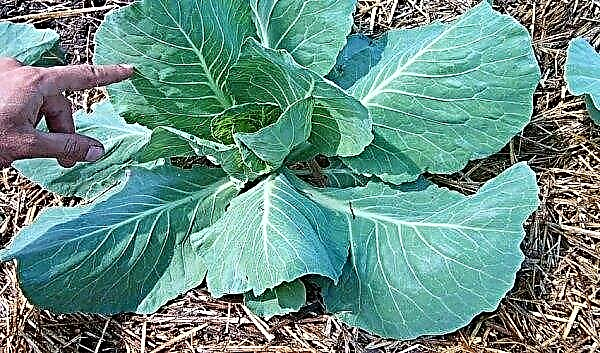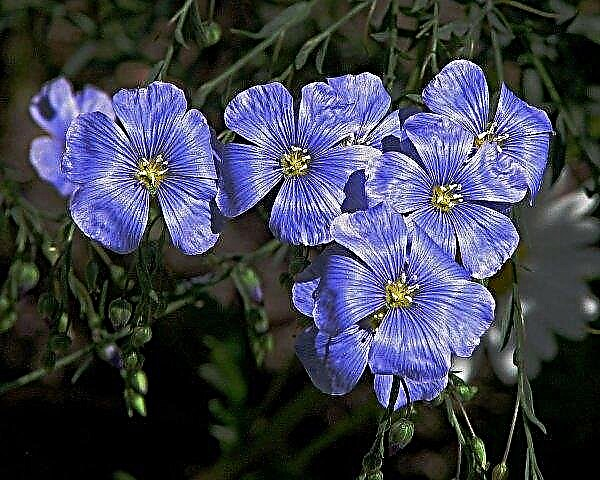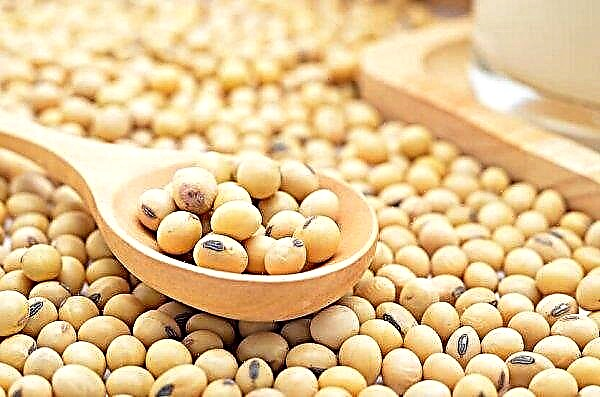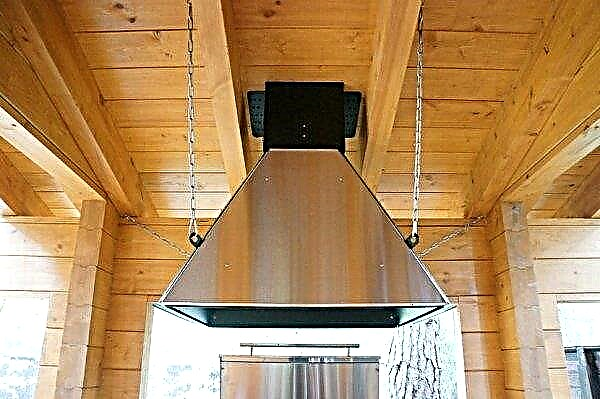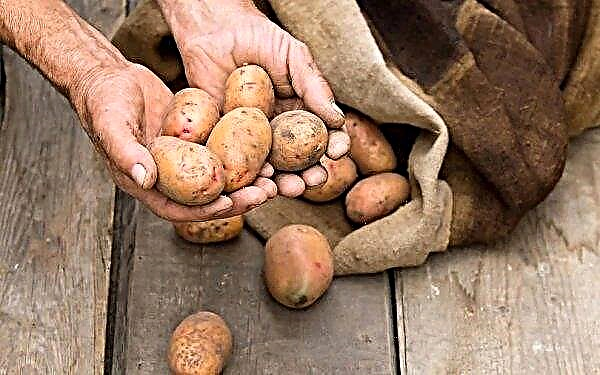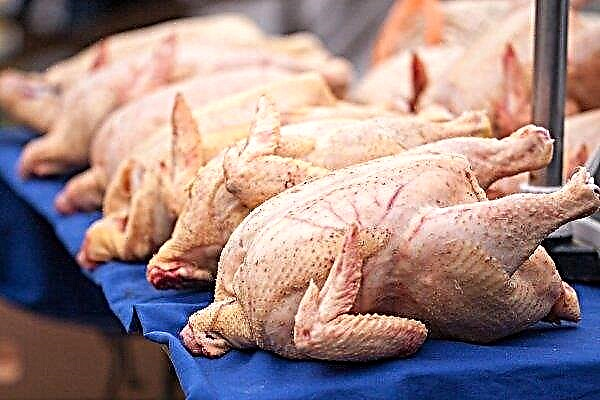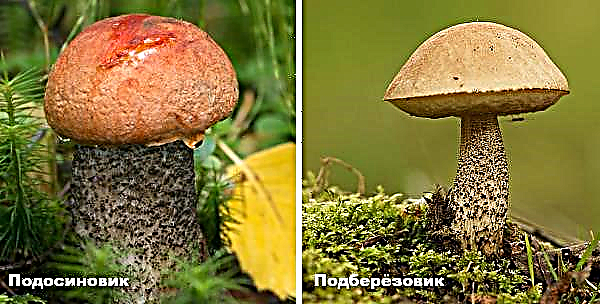Wheat is considered the most common cereal crop in the world. That is why a huge area of fields is allocated for its cultivation. This cereal is used to make flour, pasta and animal feed. But for the preservation of the crop, it is necessary to monitor the condition of the crops, and take timely measures to combat diseases and pests.
How to deal with diseases of winter and spring wheat
Most varieties of winter and spring wheat have a weakened immune system. Therefore, often on the bushes you can see signs of various diseases. Treatment must be carried out using insecticides. When choosing drugs, one should start from the characteristics of the disease, because some of them can only aggravate the situation (if the nature of the lesion is not correctly determined). Wheat can be affected by fungal, bacterial and infectious diseases. More information about combating them will be described below.
Did you know? Slavic peoples considered wheat a symbol of wealth. It was carried with you in small bags as a protection against damage.
Fusarium
A common disease of the described culture is fusarium. It affects not only bushes of wheat, but also ears. The causative agent is the Fusarium fungus. Also, signs of the disease can manifest themselves on the root system, causing huge yield losses. To preserve the potential crop, try to start treatment in a timely manner.

Spike of wheat
Symptoms of wheat spike fusaoriosis include:
- the presence of pink or orange plaque of the mycelium, which is manifested on the scales;
- the occurrence of pale pink sporulation of the fungus;
- the formation of eye spotting on the surface of the ear.
Important! Fusarium is dangerous for humans and animals if they eat baked goods or food made from infected flour. Poisoning manifests itself in the form of a lack of appetite, decreased fertility, as well as damage to internal organs (liver and kidneys).
In the early stages, the disease is localized in the shells of the grain, so the farmer is unlikely to see symptoms of damage. Literally within a week, the pathogen develops and reaches the embryo of the grain, as a result of which it becomes light in weight. The surface of the affected seeds is wrinkled, a deep groove appears on the surface.
 The fight against Fusarium infection consists in the treatment of crops with a solution of "Protioconazole" (20 g per 5 liters of water). The procedure should be carried out during the flowering of winter and spring wheat. For treatment, you can use "Tebuconazole" (30 g per 10 liters of water). For at least one hundred acre of sown area, use at least 50 liters of solution.
The fight against Fusarium infection consists in the treatment of crops with a solution of "Protioconazole" (20 g per 5 liters of water). The procedure should be carried out during the flowering of winter and spring wheat. For treatment, you can use "Tebuconazole" (30 g per 10 liters of water). For at least one hundred acre of sown area, use at least 50 liters of solution.
Fusarium Root Rot
It is often seen that wheat is affected by Fusarium root rot. The causative agents are the fungi Fusarium culmorum and Fusarius avenaceum.
Only adult bushes are affected, and manifests itself in the form of:
- brown spots on the surface of the growths;
- rot rot of the roots;
- whitening of the stem;
- voids of an ear;
- yellow or pink coating on the bushes.
 In the fight against the disease, it is recommended to use potent fungicides. Effective drugs are Impact (1 liter per 20 liters of water), Abacus (300 ml per 15 liters of water) and Ranazole (250 ml per 30 liters of water). Spraying plants is necessary after the appearance of the first signs of fusarium root rot.
In the fight against the disease, it is recommended to use potent fungicides. Effective drugs are Impact (1 liter per 20 liters of water), Abacus (300 ml per 15 liters of water) and Ranazole (250 ml per 30 liters of water). Spraying plants is necessary after the appearance of the first signs of fusarium root rot.
Wheat sclerotinia
Another fungal disease that affects winter and spring wheat is sclerotiniosis. The causative agent is Sclerotinia borealis Bubak. The first signs of the disease can be observed immediately after the snow melts. Symptoms are the presence of gray plaque with cotton-like clusters, which are localized on the leaves and stems. Over time, the disease develops, provoking the appearance of brown spots on the surface. First, leaves fade on the bushes, and then (literally a week later) black sclerotia appear in the tillering nodes. The infected parts of the bush die off soon and about 40% of the crop is lost. The treatment of sclerotiniosis consists in treating the inoculum with a solution of “Triazole” (300 g per 10 l of water) and “Benzimidazole” (100 g per 10 l of water). At least one liter of the working mixture is distributed on one hundredth.
Did you know? The Slavs considered wheat a symbol of life and wealth. Wheat grain is a necessary component of most popular plots for fertility, wealth and happiness.
Agrotechnical control measures include:
- Deep plowing.
- Liming.
- Weed removal.
- Compliance with the optimal timing of sowing.
- Planting resistant varieties.
- Early spring top dressing.

Septoria spike
Winter and spring wheat varieties are often affected by spike septoria, which is caused by Septoria sphaeropsidales. Most affected plantations are observed in the North Caucasus.
Characteristic symptoms of the disease:
- light yellow spots with a dark border on the leaves;
- drilling stems;
- infertility of ears.
To prevent septoria, it is necessary to adhere to optimal crop rotation and timely fertilizer. Also try to plant wheat varieties with a well-developed immune system.

Rot
There are several types of rot that affect a bush of wheat:
- helminthosporious. It affects seedlings, provokes the death of bushes. First, dark necrosis appears on the plant, localized in coleoptile. After some time, the underground internode and the base of the stems turn brown. The roots rot and die. The treatment consists in processing the crops with the Gambit solution (40 g per 10 liters of water). At least one liter of the working mixture is distributed on one hundredth;
- opiobial. It provokes the death of productive stems during the growing process. Symptoms of the disease are blackening of the root system and the delayed development of bushes. As a fight against the disease use the drug "Graminion" (50 g per 5 liters of water). Spraying the sowing is necessary during the appearance of the first seedlings, using at least 40 liters per one hundredth.

Smut
Symptoms of a headache are as follows:
- Parts of the ear turn into a dusty mass of dark color, which is covered with a thin film.
- The appearance of black stripes on the leaves.
- Slowed bush growth.
- Void grains.
Active development of the disease occurs if the ambient temperature is in the range from + 18 ° С to + 20 ° С, and the humidity reaches 80%. The treatment is using insecticides. When the first seedlings appear, they spray the crops with the Boreya solution (300 g per 10 liters of water).Important! In cases where cereal crops are affected by smut, the yield is reduced by 27%. Therefore, it is necessary to start treatment of the bushes at the first manifestations of the ailment.

Ergot
Ergot is considered a dangerous disease, which can destroy at least 20% of the crop. The causative agent is the fungus Claviceps purpurea. The source of secondary infection is anaforms that spread by insects and the wind. Most ergot horns retain their mycelium for two years, and can occur at any time.
Signs of illness include:
- the appearance of sticky fluid on an ear or panicle;
- the appearance of black-purple sclerotia on the surface of the bush;
- shedding of grain;
- slow development of culture.
Planting protection consists in early sowing of grain crops, timely harvesting and thorough cleaning of the seed. Also, "return" the wheat to the field no earlier than 2 years later. It is necessary to give the soil rest and recover.
 It is necessary to combat ergot by monthly treatment with a solution of Karbofos (400 g per 10 liters of water). At least one liter of the working mixture is used per one hundredth.
It is necessary to combat ergot by monthly treatment with a solution of Karbofos (400 g per 10 liters of water). At least one liter of the working mixture is used per one hundredth.
Powdery mildew
Symptoms of powdery mildew:
- white spider web coating on the stems;
- brown spots on the leaves, which are covered with black fruit bodies cleistothecia;
- the appearance of ellipsoidal spores on ears.
To cure wheat, you will need to conduct a one-time treatment of bushes with a solution of Bordeaux liquid (300 g per 50 liters of water). This volume of the working mixture is distributed on one hundredth.

Rust
When wheat is affected by rust, symptoms first appear on the surface of leaf sheaths. In the epidermis of the grain culture, a mycelium develops, which grows in the form of rusty-brown spores. First, the surface that is involved in photosynthesis decreases in the affected bushes. Uredospores provoke rupture of the epidermis, which leads to a violation of the water balance. Toward the end of the vegetation process, the fungus develops in the places where uredinias form and contributes to the appearance of black stripes about 2.2 cm long.
To treat rust, you need to use highly effective drugs that are sold in agricultural stores. Well proven "Abacus" (30 g per 10 liters of water) and "Gambit" (40 g per 20 liters of water). The optimal volume of working fluid, per one hundredth, is not less than 60 liters.

Leaf spotting
This disease was first discovered in the United States in the 60s of the last century. Symptoms are manifested at the stage when the spike enters the tube. Signs of the disease are the presence of white or yellow necrosis on the leaves. Lesions increase at a tremendous speed and turn into spots of gray or light brown hue.
You can also notice darkening of scales on the bushes. The intensification of leaf spot development is observed in hot weather. The fight against the disease is to use the Eraser or Bemorad. To dilute the preparations, it is enough to mix 300 ml of each substance and 20 liters of water. Try to spray plants in the early spring.

Bacteriosis
Bacteriosis often affects winter and spring wheat. This disease rarely appears during the formation of seedlings. The active development of bacteria begins 2-3 weeks before harvesting. In the process of the negative impact of pathogens, about 25% of valuable raw materials can be destroyed.
Striped
The causative agent of striped bacteriosis is Pseudomonas fluorescens. It provokes rotting of the stem and a decrease in the germination of grain. Most often, the disease appears due to an unfavorable hot climate and poor-quality care, which increase the susceptibility of the culture to pathogenic bacteria. Tattu (20 g per 10 l of water) and Agat-25 (250 ml) are considered effective agents in the fight against striped bacteriosis. for 10 liters of water). Treatment is carried out at the first symptoms of the disease (elongated dark spots on the leaves and stems). About one liter of solution will be needed per one hundredth.

Basal
The causative agent of basal bacteriosis is Pseudomonas syringae. The characteristic signs of the disease are damage to the lower scales, as well as the spotting of plants that are at the stage of vegetation.
When the disease is just beginning to develop, transparent spots of a yellow or brown shade, elongated shape appear on the surface of the leaves. Within a few weeks, the disease develops actively, and the affected areas dry out. Often the lower part of the stem is painted in dark colors. With the active development of basal bacteriosis, the ear is deformed, and the germ of the grain becomes brown.
If you do not start timely treatment, then the commodity quality of the product worsens and the germination rate of the seed is reduced. The fight against the disease consists in spraying the culture with a Tornado solution (300 g per 20 liters of water). At least 70 liters of working fluid will be required per one hundredth.

Yellow
The causative agent of yellow bacteriosis is the wheat nematode larva - Anguina tritici. She is able to maintain its viability, being in the soil for 5 years. If the culture is infected, a yellow or white spot of longitudinal shape appears at the edges of the leaves. In the first few days, the affected tissue is covered with a brilliant coating, and after that it dries and dies.
To get rid of yellow bacteriosis, you will need to conduct a one-time treatment of inoculation with Kolosal solution (20 g per 10 liters of water). For spraying one hundred parts, at least 50 liters of working fluid will be required.

Wheat pests and ways to deal with them
Winter and spring wheat varieties can be affected by pests, which are not only able to destroy most of the crop, but are carriers of various bacteria and fungi that provoke the development of diseases. If you want to protect plantings from parasites, then not only the use of chemicals will be required. It is necessary to monitor the quality of care, timely loosen the soil and remove weeds.
Did you know? Egyptian pharaohs were buried with necklaces made of wheat and barley. It was believed that such jewelry would protect the rulers in the other world from adversity and curses.
Red Bug (Barn Weevil)
Many farmers attribute the red bug (another name - barn weevil) to one of the most dangerous pests for cereals. Most often it is found in regions with a hot climate. This parasite gnaws grooves in the ground, and its larvae eat grains from the inside. Such an impact significantly reduces the mass of grain raw materials, and worsens the germination of the seed. The red bug, in addition to “own” harm, is able to negatively affect cereals by the fact that it carries smut spores.
 The body length of an adult beetle is about 4 mm, dark brown, shiny. Pest control methods are aerosol and gas degassing. For this, you can use the preparations "Methyl bromide" and "Chlorophos".
The body length of an adult beetle is about 4 mm, dark brown, shiny. Pest control methods are aerosol and gas degassing. For this, you can use the preparations "Methyl bromide" and "Chlorophos".
Grass aphid
Large cereal aphids are characterized by a fusiform body shape, whose length is about 3 mm. It has a yellow-brown color. The pest hibernates in winter wheat crops and does not form colonies. It can also be found in places of storage of products (barns). It feeds mainly on the upper part of the ear. If it is not timely to start eliminating the parasite, then a high probability of the death of part of the crop. The amount of losses is not less than 25 c / ha. To destroy cereal aphids, it is recommended to use a solution of Mortir and Thiophene. It is necessary to take 40 g of each substance, and dilute in 10 liters of water. Spraying is carried out in a volume of 50 liters of working fluid per one hundredth.
Wheat thrips
Pest Description:
- body length - 2 mm;
- form - elongated;
- the belly is parallel to the ground;
- the presence of wings;
- larvae are bright red, with dark legs and antennae.
Wheat thrips affects only the ear. With the help of antennae sucks juice from grains. Damaged areas are covered with white coating and dry. To destroy the pest, you will need to spray the crop with the Rakursa solution (50 g per 10 liters of water). At least 70 liters of working fluid are used per one hundredth, abundantly wetting the ears.

Grain scoop
The body of the grain scoop is small - only 2 cm in length. The wingspan is about 4 cm. The front wings are of different colors - from gray to brown, but the hind wings are grayish-brown. Insect eggs - not more than 0.5 mm in diameter. They have a light yellow hue, the surface with flat radial ribs. The larva of the grain scoop reaches a length of about 2.5 cm. In the first few days, the caterpillar has a light green color, and over time the color changes.
An adult pest that prefers to wind up in an ear does little harm to cereal crops. She eats boneless. Larvae are most harmful. They gnaw out unripe grains. One larva is able to destroy about 0.2 g of seeds in one day. Over the entire growing season, the grain scoop and its larvae reduce yield by 200 kg per hectare.
 You can deal with the pest if you spray in a timely manner. For these purposes, it is recommended to use "Pankotseb" and "Methionine." Mix 15 ml of each preparation in 10 l of water and process the crops. About one liter of working fluid is consumed per one hundredth.
You can deal with the pest if you spray in a timely manner. For these purposes, it is recommended to use "Pankotseb" and "Methionine." Mix 15 ml of each preparation in 10 l of water and process the crops. About one liter of working fluid is consumed per one hundredth.
Sawflies
The body of the cereal sawfly reaches 9 mm in length. It is oblong in shape and has a black tint. Yellow stripes can be seen on the pest's belly. Sawers feed on the internal tissues of the stem. As a result, a thin spike with empty grains forms on the bushes. Against the sawfly, it is advisable to use solutions of the Medea (67 ml per 10 l of water) and Tersela (47 g per 10 l of water) preparations. Spray the crops immediately after you notice the pest. Otherwise, it can destroy up to 120 kg of grain per hectare. The optimal amount of working fluid is 50 liters per one hundredth.

Bed bug bug
On spring wheat plants, traces of the bug’s vital activity can often be noticed.. This is a small black insect whose body is only 4 mm long. The parasite feeds on grains, which significantly reduces yield indicators. The fight against the bug is to spray the plants with a solution of "Karate-Zion" (70 g per 10 liters of water). At least one liter of prepared liquid is used per one hundredth. If you notice signs of this pest in a week, then re-process after 14 days.

Grubs
The adult larva of the Khrushchev (chafer beetle) grows in length to 50 mm. The body is yellow-white, thick, curved. The head of the caterpillar is quite massive, brown in color. From the first days of their lives, parasites feed on the internal contents of the grain, completely emptying it. As a result, crop yields are reduced by 140 kg per hectare. Strong insecticides, such as “Dialen” and “Magnum”, help get rid of larvae of grubs. To prepare a solution for spraying, 30 ml of each preparation and 10 l of water are mixed. To process one hundred parts, about 40 liters of working fluid will be required.

Hessian fly
Outwardly, the Hessian fly looks like a small mosquito. The body length of the reddish-brown color reaches 3 mm. The head of the insect is small, with black eyes and a long mustache. The legs are long, red. Females have an ovoid belly, and males have a cylindrical. The Hessian fly eats soft varieties of wheat, in particular - stems. Affected areas of the plant die off very soon, which negatively affects the crop.
 Pest control consists in spraying with Pencocepa solution (80 g per 10 l of water). Processing is carried out in early March or in April, when there is an active laying of eggs. About one liter of working fluid is consumed per one hundredth.
Pest control consists in spraying with Pencocepa solution (80 g per 10 l of water). Processing is carried out in early March or in April, when there is an active laying of eggs. About one liter of working fluid is consumed per one hundredth.
Wireworms
The above pests are characterized by an elongated oval body shape, whose length is about 15 mm. The head is small. The color can be different, from light yellow to saturated black. Wireworms feed on soft varieties of wheat, completely destroying the kernel of the grain. As a result, seed germination is reduced, and most of the crop is lost. It is advisable to use modern insecticides in pest control. “Tanrek” (60 g per 10 l of water) and “Gorgon” (78 g per 10 l of water) are considered very effective. At least one liter of prepared solution should be consumed per one hundred parts.

So, now you know what diseases and pests affect wheat (winter and spring). To protect the crop, try to take care of the plantings in a timely manner, remove weeds and loosen the soil. Also, do not forget to observe the sowing dates to reduce the likelihood of infection of the seed material. For treatment, fast-acting insecticides should be used.

